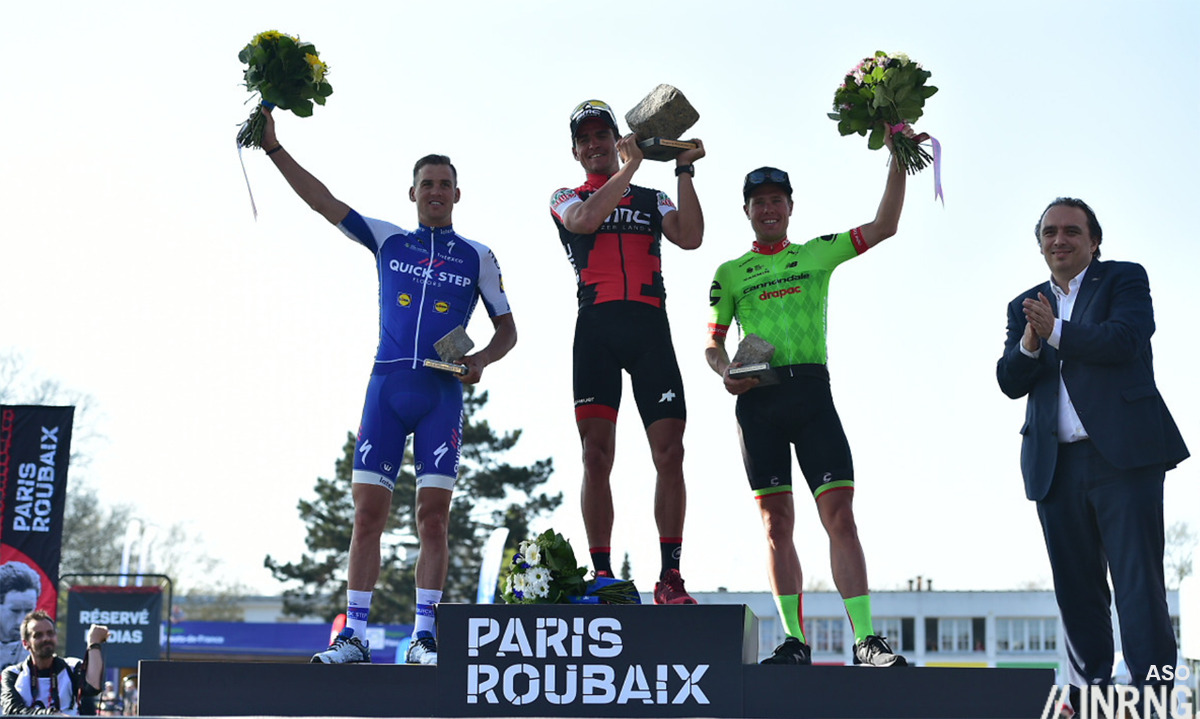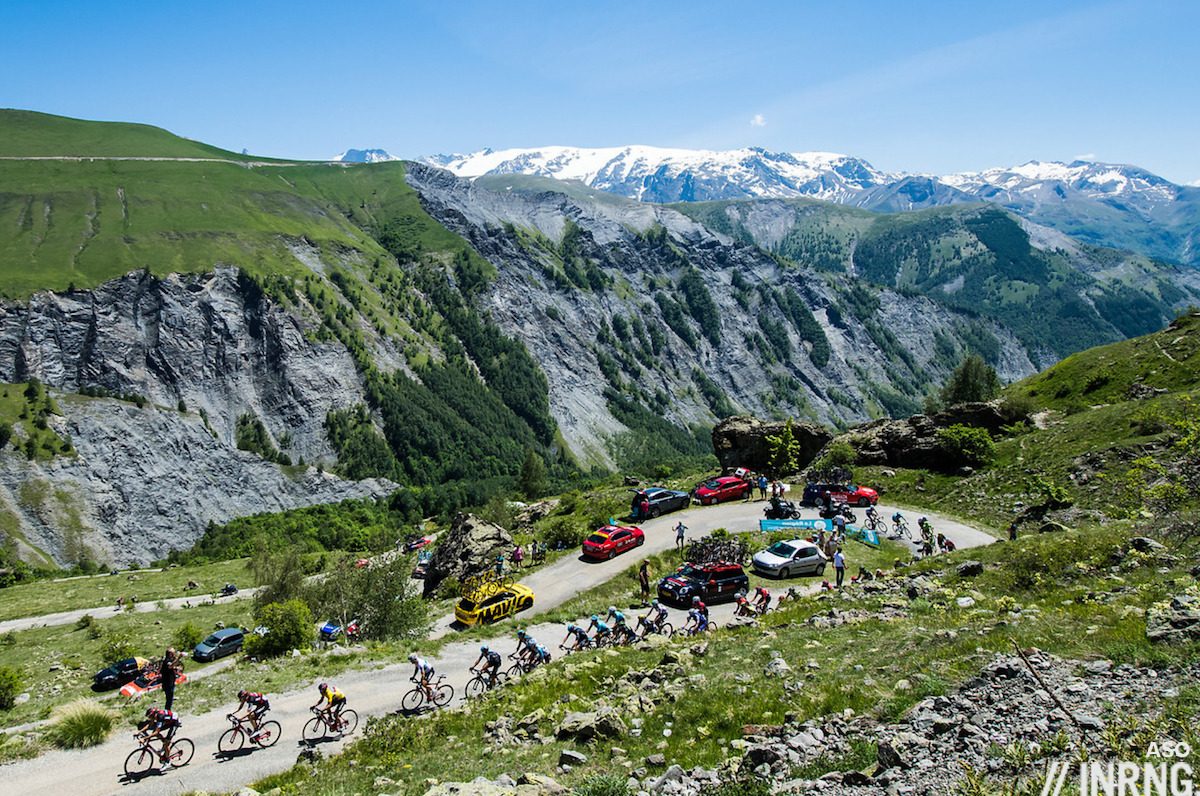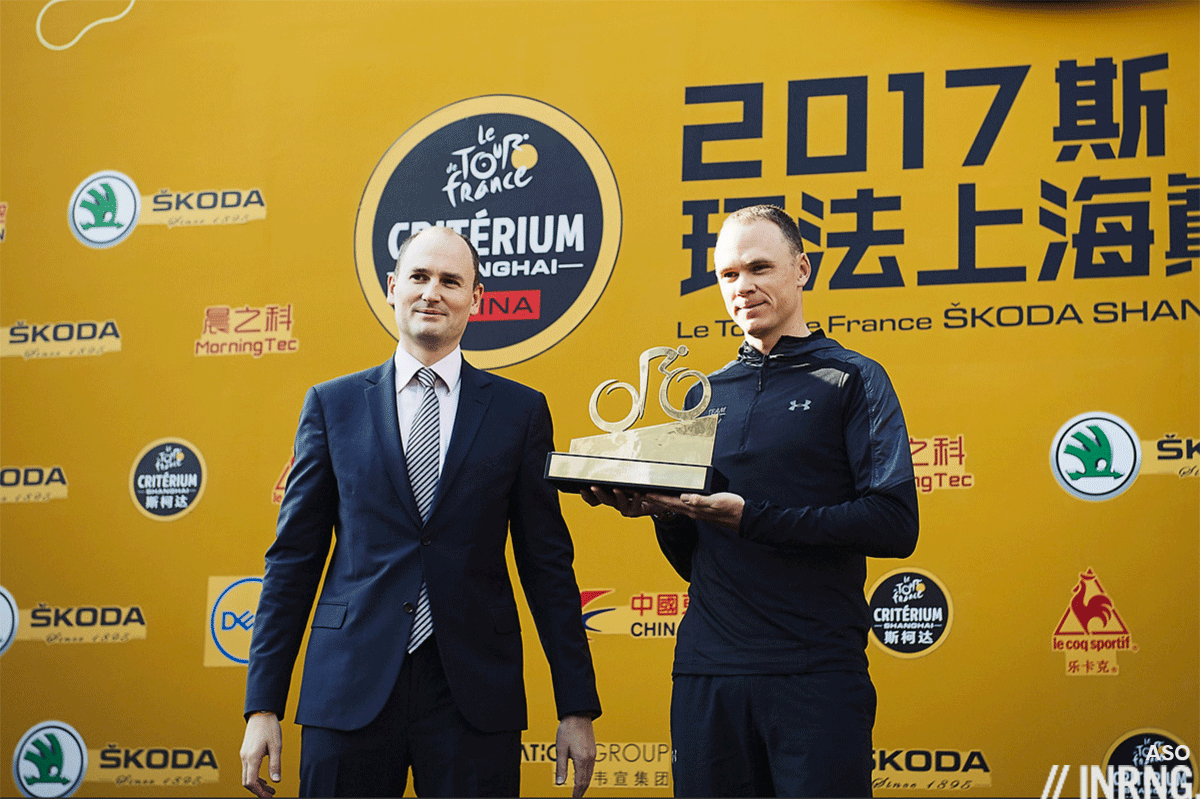Much is made of ASO’s dominant position in the sport but how much money does the Parisian race owner make? Here’s a closer look at the finances of Amaury Sport Organisation.
 The chart shows data sourced from the filed accounts of Amaury Sport Organisation. The latest set of accounts show annual revenue for 2016 of €220 million and profits of €45.9 million (highlighted in red).
The chart shows data sourced from the filed accounts of Amaury Sport Organisation. The latest set of accounts show annual revenue for 2016 of €220 million and profits of €45.9 million (highlighted in red).

Overall ASO’s finances are very healthy with growing revenues, solid profits and strong margins. On top of this the firm has next to no debts, its creditors are suppliers and the tax authorities rather than banks. The firm employed 311 people according the 2016 accounts.
The Tour de France is only a part of this. According to Wikipedia the Tour accounted for 55% of ASO’s business citing an online newspaper article which says no such thing leaving us to speculate on the importance of the Tour de France within the group. It is probably their most important asset but just how much it contributes to revenue and profits is not shown.

Other events include races you will know like Paris-Roubaix, the Critérium du Dauphiné, Liège-Bastogne-Liège, the Vuelta, the Tour de Yorkshire races as well the Arctic Race of Norway and staging the Tour of California in conjunction with AEG. New for 2018 will be the revived Deutschland Tour which is part of ASO’s dash into Germany, it has taken over the Frankfurt GP too. There’s more beyond cycling like the Tour de France à la Voile, a sailing race along the French coastline; the Paris-Dakar rally; the Open de France golf tournament; the Paris marathon and more. Paris-Dakar is a big deal for ASO and much of the commentary in the last set of accounts relate to this motorsport event.

Back in cycling there’s a push for more derivative events like the Shanghai and Saitama criteriums featuring the pros (Saitama was “a lively success” says commentary the accounts). You can ride too with events like the the Etape du Tour, not only a stage of the Tour de France on closed roads in July but now branded events around the world with participation from the likes of Chris Froome included. It’s often said several of ASO’s pro cycling events lose money and money from the Tour de France helps keep them afloat. While this sounds plausible the accounts neither show nor disprove this.

However separate accounts do exist for the Critérium du Dauphiné which ASO bought from the Dauphiné Libéré newspaper in 2010. Here is the revenue and profit lifted from the last four sets of accounts.

As the documents show the Dauphiné’s annual budget is around two million Euros and it breaks even with a meagre profit: just €11,892 for 2016. Remember this is consistently one of the best stage races of the year attracting a stellar field and offering a sublime Alpine route but it’s no money spinner.

Who owns ASO? The full name is Amaury Sport Organisation and it is a subsidiary of Editions P Amaury, a mini media empire owned in full by the Amaury family after they bought out minority shareholders in 2013 in a deal that implied the whole of ASO was worth €365 million. Marie-Odile Amaury heads up the Groupe Amaury and her son Jean-Etienne (pictured) is président of ASO’s board which makes him the boss of the Tour de France. Christian Prudhomme may be the face of the Tour de France but he’s staff. The last set of accounts show ASO paid €30 million in dividends upwards to the Editions P Amaury holding company.
History: Émilien Amaury started out as a coursier, a cyclist who delivered newspapers hot off the press to kiosks and ended up in charge of large printing firm. During World World Two and France’s Nazi occupation Amaury was given the contract to print propaganda for the Pétain regime but used his firm’s privileged status and access to rationed printing supplies to covertly print resistance materials which meant once the war ended he was able to launch the Parisien Libéré newspaper and helped to revive another title called L’Auto – today L’Equipe – and relaunched the Tour de France after its wartime hiatus. Émilien died in a horse riding accident in 1977 and after a long legal spat over the inheritance the business passed to his son Philippe and daughter Francine. Upon Philippe’s death his surviving wife Marie-Odile took over.
Today: the Amaury family sold off Le Parisien in 2015 retain L’Equipe which is now a newspaper and a TV channel. ASO is an increasingly important part of the Amaury group’s business and the Tour de France is central to this.
Conclusion
How wealthy is ASO? This piece provides the numbers and ASO’s accounts show a company in rude health with the 2016 accounts showing record revenues and profits were only just down despite taking a hit on the Paris-Dakar motorsport rally. ASO is more than the Tour de France although the race has to be its prime asset.
It’s wealthy for a race organiser in pro cycling yet for the sake of argument imagine the Tour accounts for 50% of ASO’s activities and thereby about €23 million in annual profits. This sum is hardly game-changing if it were magically to be donated to the 18 World Tour teams. Instead ASO’s power is perhaps not financial but structural because it owns and controls the sport’s biggest competition and stages more races on the pro cycling calendar than any other. Add up the races ASO owns, runs and has marketing or television distribution agreements and it accounts for 53% of the number of days of racing in the World Tour calendar.


Thanks for an informative summary. I hadn’t realised quite how much profit ASO made, I knew they were profitable but hadn’t realised to what extent.
Further to the header photo of Froome – I recorded the Eurosport highlights of the Tour Shanghai crit (round predictably empty streets) to show my other half just how dirty the air looked, and also the commentator’s (not a voice I recognised) attempt to make it sound like the result definitely wasn’t fixed, no Sir. I’d wondered before watching it if I’d be able to tell, and yes, you could.
I’d be curious to understand a little more, how ASO bundles rights to its events, because that in turn could affect how profitable any given event is. Inrng always notes when previewing ASO operated events, that local TV coverage is likely to be on whichever channel shows the Tour. The UK flavour of Eurosport, for example, seems to have rights to every ASO event, including memorably one year, a competitive race running up the Eiffel Tower!
If “Channel X” pays €1m for TV rights to a basket of ASO events including the Tour and the Criterium du Dauphinée, ASO can perhaps choose how much TV revenue is apportioned to each event. The same is probably true of advertisers who sponsor a basket of ASO events (e.g. Dimension Data’s overall data provision deal across most ASO cycling events).
Could ASO actually dictate that the Criterium du Dauphinée is revenue neutral? Might that be in their interests somehow?
It’s possible but not shown in the accounts and in all cases the money ought to show up in the ASO accounts. The bundling seems a thing, those channels buying rights to the Tour will also hold the rights to show, say, L-B-L but sometimes a channel won’t show it in full or live, from memory this happened in the US and UK with NBC and ITV.
This would suggest that they don’t bundle all the races. iTV show Dauphine highlights, all of the tour live and highlights then only highlights for the vuelta.
That’s what I was thinking. It is very suspicious that the dauphine consistently manages to have costs within a few thousand euros of income, despite income varying significantly from year to year.
Hope they will succeed in bringing the Deutschland Tour back on track.
Very insightful, and it perfectly illustrates that TV revenue sharing is not the miracle solution some team managers like to imagine.
Based on the numbers I provided in my book, ASO’s current broadcasting rights are probably between 55 and 70 million euro (and thus about a third of total ASO revenue). Let’s now assume that ASO generously gives the teams in the Tour de France a third of the TV rights (1 million per team, 22 million in total). As a consequence, ASO’s profit would be halved, from +/- 45 million to +/- 23 million. Since ASO is a private company, it is unlikely its shareholders will accept such a deal (remember the Inner Ring article mentions ASO’s shareholders received 30 million euro of dividends!).
And we’re only talking about 1 million per team, for World Tour teams at best 10% of their budget. For sure, it would be welcome, but it would not really make cycling teams financially more stable. If ASO is ever going to share TV rights money, it will probably be much less, safeguarding the upward dividend stream to the shareholders. Teams might think they will also can get money from other races, but as the example of the Dauphiné shows, cycling races usually don’t make (a lot of) profit.
Well put. But the Velon wet-dream will continue. Seems like a convenient excuse to avoid the real elephant in the room. Of the 10 listed Velon member teams, only three also belong to MPCC, so it would seem trying to get their greedy hands on ASO’s profits is far more important to them than trying to restore the credibility of pro cycling.
Pro cycling seems to be having a bit of a reset with a couple of teams cutting their rosters recently, will the rest follow? Will “Heinie’s Folly” disintegrate enough so that tens of millions aren’t required to create a decent team?
The new regime at UCI seems to understand the issues…but only time will tell if real improvements will result.
“Pro cycling seems to be having a bit of a reset with a couple of teams cutting their rosters recently, will the rest follow? ”
I took that as being part of reduced rider numbers for Grand Tours.
I think it was inrng that about Movistar cutting it’s roster from 28 to 25 (having scrolled up the page, yes it was). But actually in Movistar’s case they’re now employing 35 riders having started a womens team.
FDJ has also increased their overall commitment recently, Lotto are growing their womens team, Sunweb are pumping support at theirs, Oric keeps growing, UHC develops and Astana keep theirs ticking over.
Certainly it looks like a lot of teams are shortening up parts of their roster, but some teams are diversifying or putting some of that saving into other areas.
We don’t know all the team sizes so far (Cannondale-Drapac, Di Data and Orica-Scott have only announced 22, 18 and 21 riders when the UCI World Tour minimum is 23 per team). If we assume these three teams go for the regulatory minimum then the average shrinkage is 1.7 riders per team. It’s probably a topic to look at soon in more detail but it’s not necessarily just down to going from 9 to 8 riders in a grand tour and one fewer in the big classics etc.
This is a very important point. 45mm euro of profit doesn’t really leave a lot to spread around to the WT teams. The way everyone talks about it I assumed it had to be over 100mm. The sport is just a fringe sport with fringe revenues. Must accept that.
Don’t forget that Inrng’s analysis didn’t include the TV company, therefore we don’t know how much TV revenue sharing potential there is.
The TV entity is a separate company that is also owned by the Amaury family’s holding company. For the full picture we’d need consolidated financial statements including all other assets (including potential real estate and investments).
Are you sure? The TV rights for the Tour de France are signed with ASO and seem to be in the accounts (“droits et production”) although the sums are not specified. You could be confusing this with the L’Equipe TV channel but if you have any more info it’d be good to see.
Inrng – Interrelated companies can set transfer prices between them based on their needs to share income, not based on what the actual revenue from outside parties is.
Therefore, even though “droits et production” is shown as a separate item, it is very possible not the actual figure that the TV arm receives from advertisers, foreign cable companies, etc.
One major reason why the TdF’s organiser would NOT want to disclose the entire sum of money for TV rights is to hide it from third parties. In this case, third parties could include Velon, who want a piece of that revenue. Further, it isn’t illegal or even unethical not to disclose this. It is just a trick that is commonly used as a negotiating ploy.
I’m not the accountant representing Velon, but my next analysis would be to look at the Amaury family’s TV company and if at all possible, try to pin-point exactly how much of their revenue comes from ASO’s activities. It might not be possible though to get this detailed info, but I’d love to help.
@CA
I think that what inrng tried to say above is that the TdF rights don’t belong to the TV arm, which has pretty much nothing to do with that: they don’t sell’em, they don’t broadcast the TdF, they don’t even produce it and so on.
I understand that they can easily transfer prices between family companies, but, for example, it would be very hard to justify that a foreign company pays anything to L’Equipe TV for TdF rights which aren’t an asset of them.
OTOH, L’Equipe TV doesn’t broadcast the TdF, hence ASO can’t tell any advertiser interested in the TdF to buy air time on L’Equipe TV, because that wouldn’t be TdF-related… but, say, Giro-related (or to any other sport programme they’re actually showing)!
TdF and ASO’s L’Equipe TV are *very* separated, hence you’d need to be extremely creative to push TV rights money towards the latter without leaving any trace of them in the “Droits” part of ASO.
Sure, you can imagine (for example) ASO telling RAI: “let’s say you should pay us 15m for the TdF rights, why don’t you just pay 10m and meanwhile you buy 4-5m of whatever to L’Equipe TV?”. But that wouldn’t be easy at all, because given that L’Equipe TV is a sport television most of its shows involve rights who aren’t resellable to third parties (let’s say that RAI is interested in e-football: firstly, they should buy the rights from the event organisers, and only then they might decide to buy any L’Equipe TV production; but that’s even more complicated as L’Equipe mostly relies on the external Media365 – Groupe Sporever – for productions). That’s usually easier between TVs because if you sell a TV movie you’ve produced usually no further rights are involved.
However, sure, we can *imagine* something like this: Media365 works with lower prices for L’Equipe TV (thus bringing value to L’Equipe TV) because ASO allows Media365 to use, for their Ag2R series, some images of the Tour for which they’re paying little TV rights (thus reducing the money ASO would potentially make with those same images). Nevertheless, it looks like something quite marginal… the bulk of the rights is the broadcasting of the race, be it live or through highlights.
Guys – Gabriele and Inrng – I think you are missing the point… ASO is perfectly within it’s rights to sell TV rights of TdF from itself to the TV company at whatever price they choose. Then, the TV arm can turn around and sell them at their actual fair value to whatever outside parties it chooses, plus collect ad revenue on them. This would provide significant profits for the TV arm that aren’t disclosed here and tehrefore Velon may not know they exist.
The conversations/scenarios you bring up Gabriele don’t make sense and ASO wouldn’t be involved with them.
Yeah, but are you sure that in the scenario you describe the news about TV rights contracts would speak of ASO negotiating with RAI (it’s the European EBU group, really, but let’s keep it short), for example, instead of even naming “L’Equipe Group”, or, if anything, “EPA” (the conglomerate which owns both ASO and L’Equipe Group) as the subject which is signing a deal with the TVs?
We’re speaking (the TVs, I mean) of public companies, the agreement they sign and are made public can’t say “ASO” if the deal is with a different company, although the sellers belong to the same owner.
Gabriele – these aren’t public companies… All of Amaury’s companies, the holding company, TdF company (ASO), TV company and their other real estate and investment holding companies are privately-held. So, yes the scenarios I mentioned exist 100%.
You’re making them seem like they have public boards to answer to and detailed financial reporting requirements, but these are private companies so as long as they pay correct taxes, they can almost do what they want in terms of transfer pricing between ASO and the TV company.
@CA
I think I’ve well understood what you’re saying, while you still didn’t get my point.
I mean that most of the EBU TVs are *public* (Italian RAI surely is) which means that the contracts they sign, albeit with private entities like ASO or whatever, are made public; and the entity which is named in the *actual* case of TdF rights is *ASO* not any other subject. I suppose that you can’t sign a contract as “ASO” if you are a different company, even if you belong to the same conglomerate.
Gabriele – good point. But I understand your point.
Note that even if the EBU contract is public the largest TV contract for the ASO is in France. French TV contract is not disclosed as part of the EBU deal.
So? I vaguely recall that France Télévisions gets the domestic rights “for free” in return for producing the TV pictures for international feed, i.e. providing ASO with merchandise ready to sell. Quid pro quo or something like that.
They do pay for it, but the production costs are high (all those cameras, motos, helicopters moving every day etc) which means the reported value of the deal is lower than many might expect, talk is of €20-25 million.
Hi INRNG,
Given there are separate accounts published for CdF, is this listed as a separate entity or subsidiary of ASO? The slither of a profit posted for these past four years come along with a strong indication that there is some cross-conglomerate transfers going in – big question then is what direction the money is going.
It’s 100% owned by ASO. There’s not much more info than this in the accounts.
This is the Pretty Green,
This is society….
https://www.youtube.com/watch?v=IYsApktzkR4
INRNG – Love this blog and keep up the good work. That said I am a bit surprised at your conclusion in the article above. Given the Revenue and Profit for the CdD, it is quite clear that some other events must be contributing much higher profit margins to ASO. Is it likely that the TdF is one of those, if that is the case, then to assume that the annual profits are only €23m is probably understating the actual figure…. That said the point you are trying to support is totally valid as the profit performance of other events would limit amount ASO could contribute to the World Tour teams.
I didn’t want to start making too many assumptions, this piece tries to present the actual numbers so went with a basic idea but your assertion could well be right.
There is a line in the accounts saying a subsidiary called “Tour de France” made a profit of €9.6 million but despite the name it’s not clear if all the Tour’s activities and monies are run through this.
Great analysis as always.
Don’t get too hung up on the profit reported. These can be heavily distorted by write downs, finance and such. The Dauphine might be a little more profitable than you think – they may dump cost of acquiring it into the accounts rather than at group level.
“During World World Two and France’s Nazi occupation ..”
World World would have been nice, but unfortunately it was a World War.